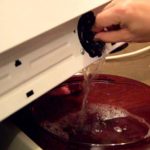If during the washing of the laundry there was a breakdown of the machine and the process stopped, you must first turn off the appliance from electricity, unplug the plug from the outlet, and then turn off the water supply tap. To gently drain the water from the tank, there are 5 reliable ways. You can use a special emergency hose, the main drain hose, or scoop up water manually through the hatch of the washing tub. Also, a drain filter and a drain pipe are suitable for removing water.
Drain hose
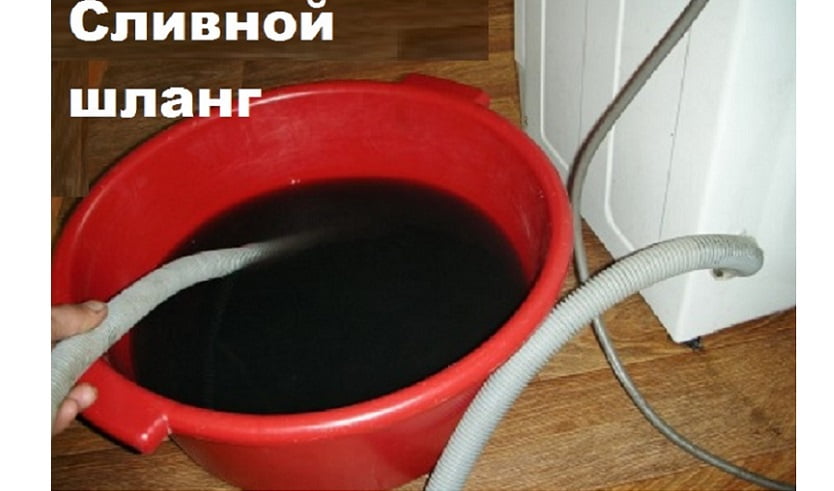
The simplest method allows you to drain the water the fastest. Procedure:
- Turn off the power, shut off the water supply.
- Disconnect the drain hose from the rear panel.
- Pull the outlet out of the sewer pipe.
- Place the end of the hose in a container (bowl or basin) that is below the level of the washing tub. The capacity is necessary low, it is difficult to drain into a bucket using this method.
If in this way the washing machine does not drain the water, then it provides protection against leaks from the sewer hose. Inside the case, manufacturers make an extra loop with a drain hose or install a plastic elbow, so the drain hose is always above the tank level. Most common in washing machines Bosh and Simens.
![]() See also - Samsung washing machine malfunction codes
See also - Samsung washing machine malfunction codes
Emergency hose
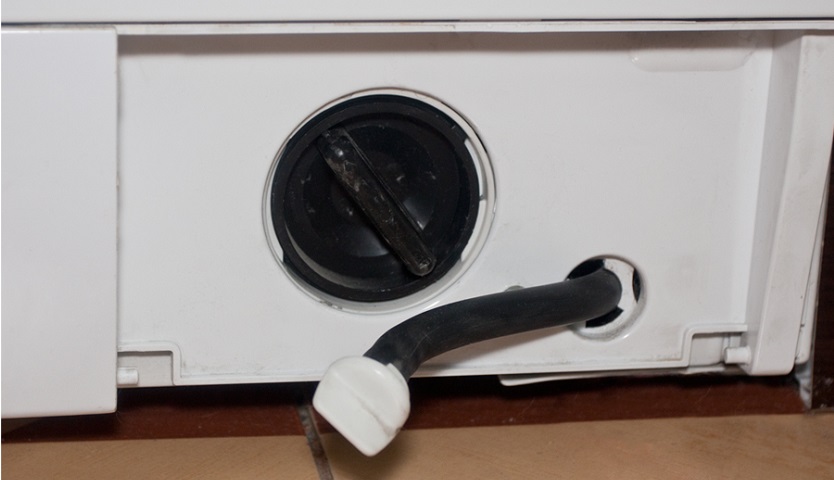
Designed specifically for draining water in the event of a breakdown. It is usually located in a special hatch at the bottom of the front panel and is closed by a small door, there is also a drain filter. In some cases, the drain mechanism is implemented as a retractable plastic channel. If you do not see the hatch on the front panel, then it is located under the plastic decorative panel at the very bottom. This design is found in Indesit washing machines.
Drain order:
- Open the hatch door, remove a thin emergency hose from the niche.
- Substitute a flat, wide container of suitable height under the hatch. Pull the plug out of the hose, place the outlet in the container.
- Control the process so that the water does not spill.
Important:
All procedures for draining water are carried out only after disconnecting the washing machine from the mains and water supply!
The disadvantages of the method:
- Long drain process - up to 30 minutes;
- The emergency hose is often clogged with scale or other debris, so the water will not drain;
- Some models do not have an emergency hose.
Tip:
To speed up the process, tilt the machine to the wall, open the hatch of the drum, and scoop out some of the water manually. The remaining water is drained through the emergency hose.
Drain filter
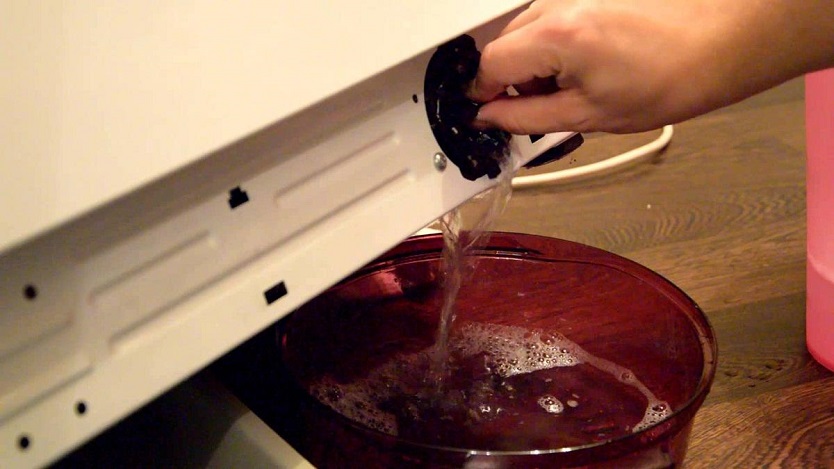
It is located along with the emergency hose, which we wrote about above. Designed specifically to protect the pump from debris, small items, lint from clothing. Drain filter cleaning The simplest and most common troubleshooting solution.
Procedure:
- Open the manhole cover at the bottom. Sometimes the hatch door can be covered with a narrow decorative panel at the bottom of the washing machine.
- Tilt the housing towards the rear panel so that you can install a low basin under the filter to collect water. For convenience, you can lean the washing machine against the wall. With a large slope, the rear legs may begin to slide on the tile, be careful.
- Turn the drain filter clockwise by the handle. To adjust the pressure of the drained water, it is not necessary to unscrew it to the end.
- Keep the machine tilted until the water stops draining into the tank. At the end of the drain, you will have to return the unit to its normal position, and then collect the remaining water manually.
Tip:
Prepare in advance, spread rags or towels, this will simplify cleaning after draining the water.
Scoop out water manually
The most obvious and easiest way to drain the water is to manually scoop it out of the washing machine through the drum hatch.
The disadvantages of the method:
- It will not work to drain all the water. As a result, the remaining water will have to be drained using a drain filter or emergency hose.
- Long and not convenient. Especially when compared with the first method.
- Sequencing:
- Open the door of the washing tub. The car with the front hatch will have to be tilted towards the rear wall so that water does not spill onto the floor. For vertical loading this is not required.
- After taking out the laundry, scoop out the remaining liquid with a bucket or a mug.
- Return the machine to its normal position. Part of the water will remain in the hose system located below the tank.
Important:
Modern cars are equipped with a door lock with a timer and open 5 to 10 minutes after turning off. If the sunroof is jammed, special emergency unlocking methods are used.
Drain pipe
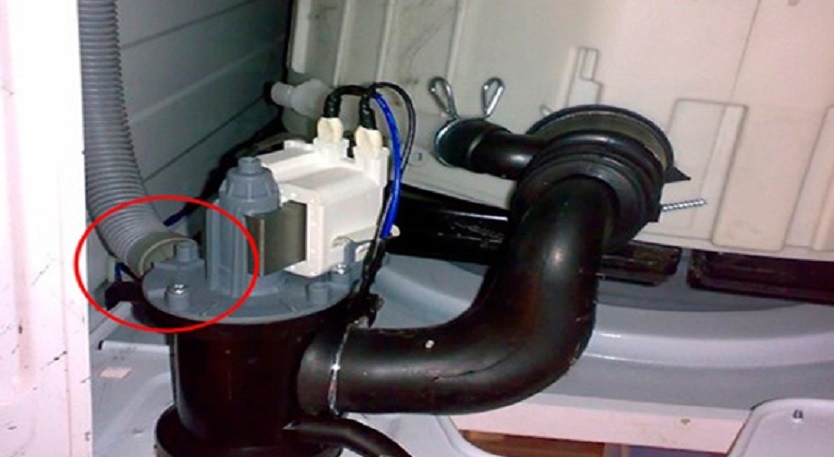
This method is used to remove water and repair the malfunction. If water does not flow out while unscrewing the drain filter and cleaning it, there is a blockage inside the drain pipe. This corrugated thick hose can be found independently according to the diagram from the instructions for your washing machine. Most often located at the bottom of the back of the washing machine.
Procedure for eliminating blockage:
- Remove the back panel, fastened with 4 screws.
- Install a water tank on the floor under the nozzle or cover the floor with towels. Depending on the location of the nozzle and pump, the machine will have to be tilted or completely laid on its side. Therefore, act on the circumstances, it may make sense to first drain the water in another way, and then proceed to clean the blockage.
- Disconnect the nozzle from the pump by carefully removing the clamp (snail).
- If the fluid does not leave, you will have to clean the blockage forcibly. This can be done with fingers, a pencil, a screwdriver, or with a soft wire hook.
- Did not help? There is another option, unscrew the nozzle from the tank and clean it thoroughly.
- After cleaning and draining the water, return all the parts of the mechanism to their place and securely fasten them. Check for leaks. Connect the device to the mains, open the tap for supplying water from the water supply.
- Close the rear panel.
Having made a simple repair, most likely the fault is fixed. Start a test wash without laundry and check the drain.
6 common problems why a washing machine does not drain
If the device does not drain or continues to generate an error, you need to determine the essence of the problem. Violations of the drain mechanism arise for 6 reasons, which we ranked by popularity, in descending order:
- Foreign objects in the drain filter.
- Drain pipe clogged.
- Pump malfunction (pump breakdown).
- Pressostat malfunction (water level sensor).
- Software failure, malfunction of the programmer in mechanical machines.
- Electronic module failure (brain).
Most of the problems associated with stopping the machine and breaking its mechanisms can be prevented if simple operating rules are followed. It is necessary to carefully check the contents of the pockets of clothing before sending it to the washing tub. Small items: pins, paper clips, coins can cause blockages. Sand, dust, crumbs, falling into the tank with linen, also often cause problems. Fabrics that can leave a large amount of pile and fibers, it is advisable to wash in special bags of fine mesh.
See also:

